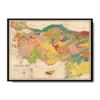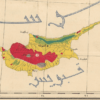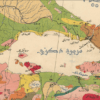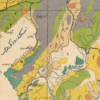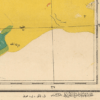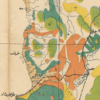Geological Map of Anatolia 1920
From: EGP460.00
This is the first comprehensive geological map of Turkey; a large, separately published work created by the professors Damat Kenan and Ahmet Malik Sayar, issued by Matbaa-ı Amire, the imperial printer, in 1920 during the twilight of the Ottoman Empire, forming the foundation for scientific and commercial discovery during the upcoming Turkish Republican Era; printed entirely in Ottoman Turkish script with resplendent original colours.
The map embraces the western three-quarters of Anatolia (to a point just to the east of Trabzon); all of Cyprus; parts of Northern Syria and Lebanon, to a point south down just past Homs and Tripoli; as well as Eastern Thrace. The map brilliantly showcases the unusually complex geology of the region which lies along the Alpine-Himalayan tectonic belt, identifying 14 distinct geological zones, each coloured in their own resplendent hue.
Additionally, symbols identify innumerable locations of mineral deposits, mines and quarries concerning 22 different minerals. Importantly, it notes the locations of major harbours, as well as delineating the region’s railroads (including the largely complete Baghdad Railway, which was to connect Constantinople with Baghdad), which were vital to bringing minerals to market. While geological maps of certain Turkish locales, as well as rough geological sketch maps of the greater region already existed,
Historical Context: The Rise of Turkey out of the Ottoman Ashes While World War I (1914-8) prefigured the demise of the Ottoman Empire, it is a common Western misconception that Turkey simply ‘collapsed’ and resigned itself to defeat. On the contrary, while most Turks accepted that the Ottoman Empire, with its vast Arab-majority provinces, was not to survive, they were reenergised by the dream of creating a new nation focused upon Constantinople and Anatolia. While the victorious Entente Powers (mainly Britain, France and Italy, along with Greece) vowed to dismember Anatolia into zones of foreign occupation, many Turks had other ideas. Mustafa Kemal Pasha (1881 – 1938), later known as ‘Atatürk’, a former Ottoman army officer and hero of the Gallipoli Campaign, rallied Turkish nationalist forces during the Turkish War of Independence (1919-22). By 1922, he succeeded in both removing the foreign occupation of Anatolia, Constantinople and Eastern Thrace, while abolishing the Ottoman Empire. In 1923, he proclaimed the Republic of Turkey, serving as its folding president for the next 15 years, whereby he did much to modernize and strengthen the new nation. He is rightly remembered as one of the most visionary and successful World leaders of the 20th Century. The present map, while still made under the outgoing Ottoman regime, was created with the new ‘Kemalist’ can-do spirit in mind. Turkish intellectuals, such as Kenan and Sayar, knew that the new Turkish state that would arise out of the ashes of the Ottoman Empire, would need to exploit its significant natural resource wealth to build a modern industrial economy, to both keep the people employed and to support the military. The present map would have been vitally useful for strategic planning, to identify the locations of mines and quarries, as well as the means of transporting minerals to refineries and markets. Curiously, the present map omits the easternmost quarter of Anatolia. This is since the political fate of the region was then disputed, while it was difficult for geologists to survey the area. In 1920, the France and Britain still claimed zones of influence over the area, while promising to give much of it to an independent Armenian state. Moreover, the location of the Soviet boundary in the region was still in doubt. As it would turn out, Atatürk would settle the location of the Soviet-Turkish boundary with Lenin in 1921, while placing almost all Eastern Anatolia under Turkish rule, a reality internationally recognized by 1923. The authors of the map were the most respected authorities on mining and geology of their era. Damat Kenan, was a professor of mining at the Darülfünun (later known as the University of Istanbul). He co-authored the map with his younger colleague, Ahmet Malik Sayar (1892 – 1965), then a lecturer at the Darülfünun, as well as an instructor at the Halkalı School of Agriculture. The French-educated Sayar, who went on the publish numerous seminal academic studies, was subsequently recognized at the greatest Turkish geologist of the 20th Century. A Note on Rarity The present map is very rare; we cannot trace any institutional examples outside of Turkey. References: SALT Research Centre (Istanbul)
Map Info
Creator: Ahmet Malik Sayar, Damat Kenan
Date: 1920
Language(s): Ottoman Turkish
Scale: 1:500,000
Location: Anatolia, Turkey
| Size | A3, A2, A1, A0 |
|---|
People Also Purchased
-
Postage Stamps Stickers
EGP90.00 -
Frame
From: EGP250.00 -
Postcards Egypt 1826
EGP50.00 -
Magnifying Glass
EGP120.00
Related products
-
Alexandria 1933
From: EGP460.00 -
City of Manila & Vicinity 1955
From: EGP460.00 -
Classified Map of Secret Nazi Transport Routes 1941
From: EGP460.00 -
Commercial Map of the Near East 1921
From: EGP460.00 -
Damas 1939
From: EGP460.00 -
Damietta 1941
From: EGP460.00 -
El Mina – Tripoli 1958
From: EGP460.00 -
Gaza 1917
From: EGP460.00 -
Jerusalem 1942
From: EGP460.00 -
Kuala Lumpur 1957
From: EGP460.00 -
Kuwait 1958
From: EGP460.00 -
Map of Arab League States 1960
From: EGP460.00



